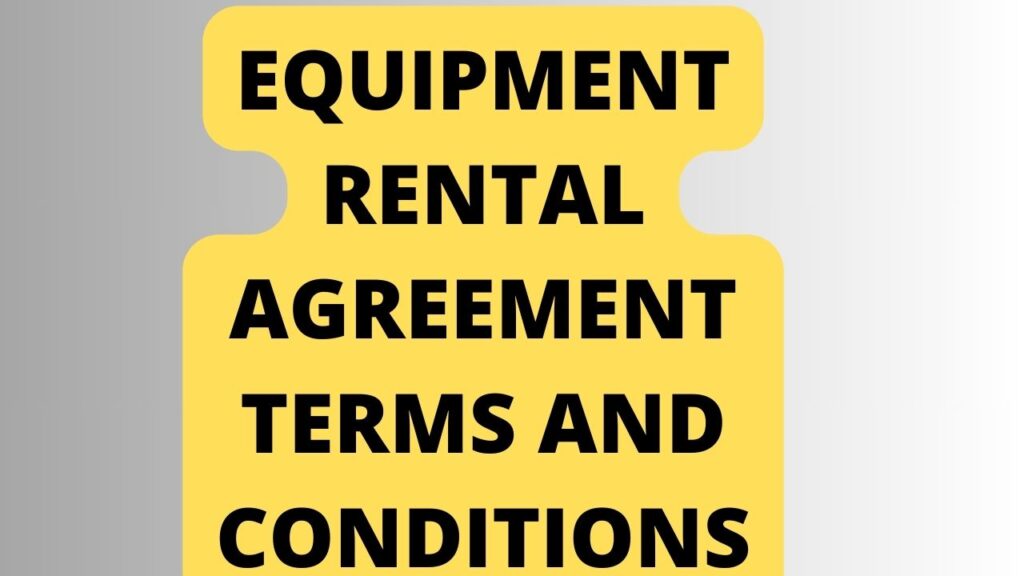Introduction
Equipment Rental Agreement Terms And Conditions Rental agreements for equipment lay out the terms and conditions governing the usage of specific items or machinery. Understanding these terms is vital as they dictate responsibilities, liabilities, and the nature of the agreement between the involved parties.
Equipment Rental Agreement Overview
Such agreements entail a detailed description of the equipment being rented, the involved parties (renter and lessor), the duration of the agreement, and the scope of usage.
Key Terms Explained
- Equipment Description and Specifications: The agreement should comprehensively describe the equipment, its condition, and any specifications or unique features.
- Rental Payments and Charges: Clear delineation of the rental fees, payment schedules, additional charges, and penalties for defaulting.
- Insurance and Liability: Details about insurance coverage, liability in case of damage or loss, and responsibility for maintenance and repairs.
Conditions for Use
- Maintenance and Repairs: Highlighting the responsibilities of both parties concerning maintenance, upkeep, and repair costs.
- Usage Restrictions: Stipulations regarding the permissible use, location, and potential modifications to the rented equipment.
- Termination Conditions: Outlining circumstances leading to the termination of the agreement, including breach of terms or completion of the rental period.
Legal Obligations
- Dispute Resolution: Procedures for resolving conflicts or disagreements arising during the rental period.
- Jurisdiction and Governing Law: Indication of the legal jurisdiction and the governing law applicable to the agreement.
- Amendments and Modifications: Procedures for making amendments or modifications to the agreement, ensuring they are documented and agreed upon by both parties.

What is an Equipment Rental Agreement?
An Equipment Rental Agreement, commonly known as a lease agreement, is a legally binding contract outlining the terms under which one party (the lessor) agrees to rent out equipment to another party (the lessee). This agreement encompasses various crucial aspects, delineating the rights and responsibilities of each party involved.
Importance of Understanding Terms and Conditions
The terms and conditions within an Equipment Rental Agreement serve as the blueprint guiding the rental transaction. They encompass vital details, including the description of the equipment, rental duration, financial obligations, maintenance responsibilities, and legal liabilities.
Key Sections of a Rental Agreement
Identifying Parties Involved
The agreement initiates by identifying the parties involved—the lessor (equipment owner) and the lessee (renter). Clear identification of both parties with accurate contact details avoids any ambiguity.
Description of Equipment
A detailed description of the rented equipment, including make, model, serial number, condition, and any specific features, ensures clarity and minimizes disputes regarding the equipment’s state upon return.
Rental Period and Costs
Defining the rental duration and the associated costs, such as the rental fee, security deposit, and any additional charges, is fundamental. Clarity on payment schedules mitigates misunderstandings.
Terms of Use and Maintenance Responsibilities
This section delineates the permissible uses of the equipment and the lessee’s responsibilities for its maintenance, upkeep, and any necessary repairs during the rental period.
FAQs
- What happens if the equipment gets damaged during the rental period?
- Explanation of liability and procedures for addressing damages.
- Are there any restrictions on the usage of the rented equipment?
- Details regarding usage limitations and permissible modifications, if any.
- Can the rental agreement be extended beyond the agreed-upon period?
- Explanation of extension possibilities and associated procedures.
- What happens if the rental payments are delayed?
- Clarification on late fees and potential consequences.
- Who is responsible for insurance coverage during the rental period?
- Explanation of insurance responsibilities for the equipment.
- How can disputes be resolved if they arise during the rental period?
- Overview of dispute resolution mechanisms outlined in the agreement.
Conclusion
Mastering the nuances of an Equipment Rental Agreement’s terms and conditions is indispensable for fostering a transparent and mutually beneficial arrangement between lessors and lessees. Clarity, understanding, and adherence to the terms outlined in the agreement form the bedrock of a successful and harmonious rental experience.
